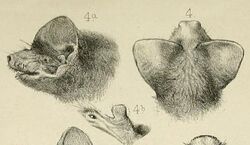Biology:East-coast free-tailed bat
| East-coast free-tailed bat | |
|---|---|

| |
| Scientific classification | |
| Kingdom: | |
| Phylum: | |
| Class: | |
| Order: | |
| Family: | |
| Genus: | |
| Subgenus: | M. (Micronomus)
|
| Species: | M. norfolkensis
|
| Binomial name | |
| Mormopterus norfolkensis J.E. Gray, 1840
| |
The east-coast free-tailed bat (Mormopterus norfolkensis) is a species of bat in the family Molossidae, the free-tailed bats. Other common names include eastern little mastiff bat[1] and eastern freetail-bat.[2] This bat is endemic to Australia , where it occurs from southeastern Queensland to eastern New South Wales.[1]
Description
This bat has dark brown to reddish brown fur with a paler belly.[2]
Biology and ecology
The species has been collected only occasionally, and little is known about its biology and ecology. Though the species may roost communally, it is usually solitary.[2]
Range and habitat
It has been observed in dry eucalypt forest, wet sclerophyll forest, and riparian rainforest habitat. A colony was found roosting in a house.[1] Females with young have been observed in grey mangrove (Avicennia marina) forests.[3]
Conservation
It is thought that there are fewer than 10,000 mature individuals. Threats to the species may include habitat loss from timber harvesting, coastal development, and alterations of natural fire regimes.[1]
References
- ↑ Jump up to: 1.0 1.1 1.2 1.3 1.4 Richards, G.; Pennay, M. (2008). "Mormopterus norfolkensis". The IUCN Red List of Threatened Species 2008: e.T13885A4361614. https://dx.doi.org/10.2305/IUCN.UK.2008.RLTS.T13885A4361614.en.
- ↑ Jump up to: 2.0 2.1 2.2 Eastern Freetail-bat Profile. Threatened Species. Office of Environment and Heritage. NSW Government. Downloaded on 25 March 2015.
- ↑ McConville, A., Law, B. S., & Mahony, M. J. (2013). Mangroves as maternity roosts for a colony of the rare east-coast free-tailed bat (Mormopterus norfolkensis) in south-eastern Australia. Wildlife Research 40(4), 318-27.
Wikidata ☰ Q1829472 entry


